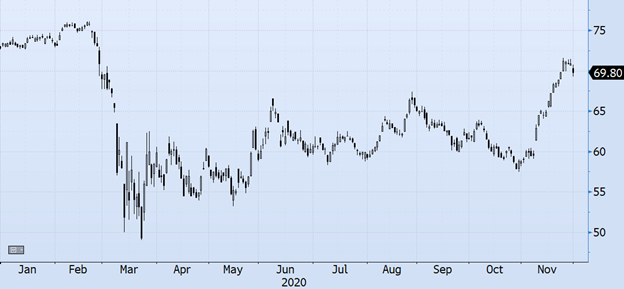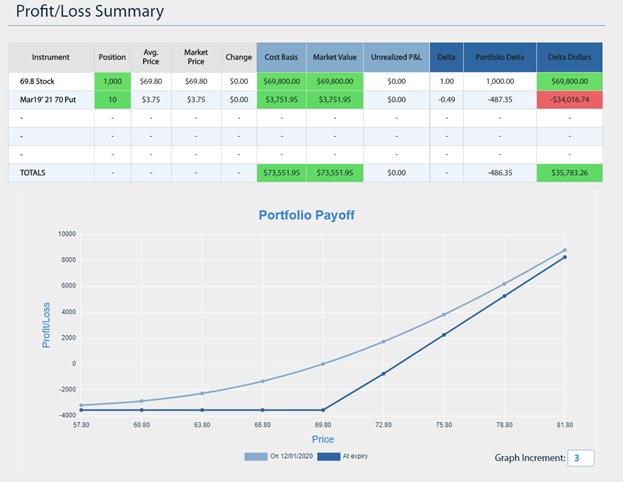Protective Put in Toronto Dominion Bank

Canadian investors love bank stocks. And why not? They have been terrific investments throughout the years.
Take a company like Toronto Dominion Bank (symbol TD). It pays a dividend of $0.79 per quarter and had an indicated yield of 4.53% at the time of writing this article. In our current environment of rock-bottom interest rates, this yield is awfully attractive.
However, TD is still a bank stock. The emphasis is on that last word: “stock.”
Stocks have no par value and do not mature like bonds. They are therefore more volatile and entail more risk than bonds.
So when an investor has the good fortune of having a stock position rise in price over a short period of time, it is always prudent to consider whether the time is right to hedge that position, to protect against subsequent declines.
For example, consider TD. Over the past month, the stock has risen almost 19%. At the end of October, TD was $58.80, and it ended November at $69.80.
Chart 1: Toronto Dominion Bank (symbol TD) Year to Date

Source: Bloomberg
After having the good fortune of seeing TD’s stock price rise $11, an investor might consider spending a portion of that profit to purchase a put option to protect against potential declines – if only to sleep easier at night.
For example, the investor could purchase a March 21, 2021 put option with a strike price of $70 for $3.75 per contract. So for approximately 1/3 of the profit from the last month’s surge in the stock’s price, the price of TD can be locked in, and any decline below $70 would be hedged.
By owning a put option, the investor purchases the right, but not the obligation, to sell TD at any time between the purchase date and expiration date at the strike price.
The following diagram shows the potential profits and losses for the investor who owned 1,000 TD bank shares and chose to hedge them by purchasing put options.
Chart 2: Portfolio P&L for long 1,000 TD and long 10 PUT TD Mar 2021 puts with a $70 strike

Source: Bigpicturetrading.com
This profit and loss diagram shows that the maximum loss from this point forward is $3,550. However, don’t forget that the investor has a gain of $11,000 from the last month.
The nice part about this strategy is that if TD continues to rally, the investor can still participate, and simply lets the puts expire without exercising them.
But if TD declines, then the investor can exercise their puts, thereby selling the stock at $70, or they can sell the puts for a profit. In either case, the investor is then free to enter into a new hedged or unhedged strategy.
Using put options after sizable gains represents an attractive way for investors to lock in their profits, and it creates more opportunities to trade around a core position.
Although we have used the example of TD Bank, this strategy can be applied to any stock that has experienced a large run. Investors should not only be thinking “is it time to sell?” – they should consider an alternative: “is it time to hedge?”
Disclaimer:
The strategies presented in this blog are for information and training purposes only, and should not be interpreted as recommendations to buy or sell any security. As always, you should ensure that you are comfortable with the proposed scenarios and ready to assume all the risks before implementing an option strategy.
Derivatives Market Specialist
Big Picture Trading Inc.
Patrick Ceresna is the founder and Chief Derivative Market Strategist at Big Picture Trading and the co-host of both the MacroVoices and the Market Huddle podcasts. Patrick is a Chartered Market Technician, Derivative Market Specialist and Canadian Investment Manager by designation. In addition to his role at Big Picture Trading, Patrick is an instructor on derivatives for the TMX Montreal Exchange, educating investors and investment professionals across Canada about the many valuable uses of options in their investment portfolios.. Patrick specializes in analyzing the global macro market conditions and translating them into actionable investment and trading opportunities. With his specialization in technical analysis, he bridges important macro themes to produce actionable trade ideas. With his expertise in options trading, he seeks to create asymmetric opportunities that leverage returns, while managing/defining risk and or generating consistent enhanced income. Patrick has designed and actively teaches Big Picture Trading's Technical, Options, Trading and Macro Masters Programs while providing the content for the members in regards to daily live market analytic webinars, alert services and model portfolios.
The information provided on this website, including financial and economic data, quotes and any analysis or interpretation thereof, is provided solely for information purposes and shall not be construed in any jurisdiction as providing any advice or recommendation with respect to the purchase or sale of any derivative instrument, underlying security or any other financial instrument or as providing legal, accounting, tax, financial or investment advice. Bourse de Montréal Inc. recommends that you consult your own advisors in accordance with your needs before making decision to take into account your particular investment objectives, financial situation and individual needs.
All references on this website to specifications, rules and obligations concerning a product are subject to the rules, policies and procedures of Bourse de Montréal Inc. and its clearinghouse, the Canadian Derivatives Clearing Corporation, which prevail over the content of this website. Although care has been taken in the preparation of the documents published on this website, Bourse de Montréal Inc. and/or its affiliates do not guarantee the accuracy or completeness of the information published on this website and reserve the right to amend or review, at any time and without prior notice, the content of these documents. Neither Bourse de Montréal Inc. nor any of its affiliates, directors, officers, employees or agents shall be liable for any damages, losses or costs incurred as a result of any errors or omissions on this website or of the use of or reliance upon any information appearing on this website.
BAX®, CADC®, CGB®, CGF®, CGZ®, LGB®, MX®, OBX®, OGB®, OIS-MX®, ONX®, SCF®, SXA®, SXB®, SXF®, SXH®, SXM®, SXO®, SXY®, and USX® are registered trademarks of the Bourse. OBW™, OBY™, OBZ™, SXK™, SXJ™, SXU™, SXV™, Montréal Exchange and the Montréal Exchange logo are trademarks of the Bourse. All other trademarks used are the property of their respective owners.
© 2024 Bourse de Montréal Inc. All Rights Reserved.
